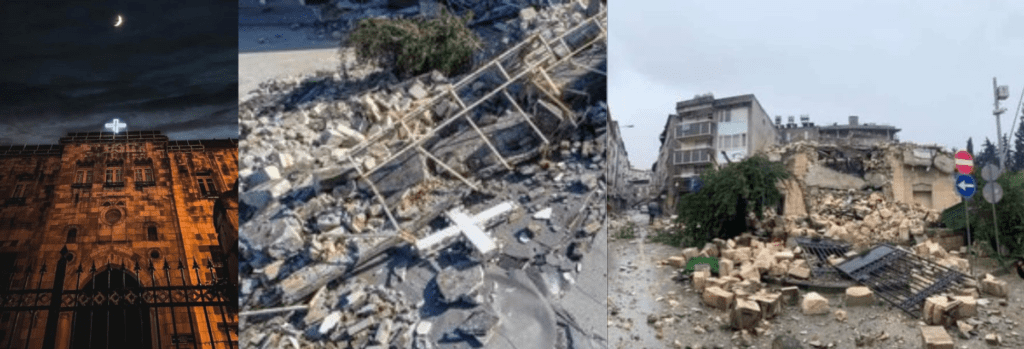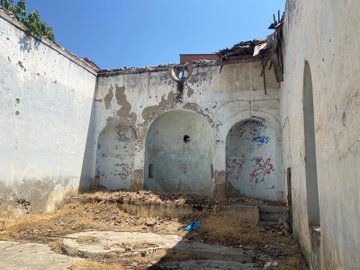HAKAN MERTCAN
Antioch was one of the provinces that was hit hardest by earthquakes that took place on February 6, 2023. This disaster was compounded by subsequent earthquakes that took place on February 20, 2023, and in a sense, Antioch became the capital of destruction and anxiety. The earthquakes devastated Antioch and many parts of the historical city turned into rubble. In the tragedy which cost the lives of tens of thousands of people and animals, many historical and cultural heritage sites were also damaged or destroyed to various degrees. Unfortunately, many buildings that were considered historic places of worship were also included in this dismal list.
A wreckage is all that remains of Kurtulus (Herod) Street, the world’s first illuminated street, and the nearby district, both of which had been home to many historical sites in Antioch. For example, the dome, minaret, and walls of Habib-i Neccar Mosque, which was built after the Muslims took over the city in the 7thcentury and is considered one of the first mosques in Anatolia, collapsed after the earthquake. The Habib-i Neccar is also important for Christians since it is home to the tombs believed to belong to the apostles Yuhanna (John) and Pavlus (Paul), who came to Antioch to spread the teachings of Jesus. Habib Neccar was said to be the first person to adopt their message. Located in the same district, the historical Sarimiye Mosque, a historical synagogue, and a Catholic church were also damaged.
It should be noted that Affan Kahvesi (Affan Coffee Shop), which was built in the 1910s and has become an important symbol of Kurtulus Street, was also seriously damaged. The historical Uzun Bazaar (Sûk it-Twîl), located in the area between Kurtulus Street and the Asi (Orontes) River, had been one of the significant reflections of the multi-identity and multi-cultural structure of the city. Unfortunately, it was also severely damaged.
Ulu Cami (The Great Mosque), built by the Mamluks in the 16th century, was completely destroyed, as was the Antioch Protestant Church. The building, which was built in the 1920s and served as an embassy and then as a bank during the French period, began to be used as a Protestant Church in 2000. The Greek Orthodox Church of Antioch (Saints Peter and Paul Greek Orthodox Church), which had a historical character, is now decimated and has become unusable. The Chairman for Antioch Greek Orthodox Church Foundation Fadi Hurigil who said, “the church bell fell, the call to prayer stopped, the hazzan [also known as a cantor] is under debris,” also emphasized that Antioch, one of the three great metropolises of the Ancient Age, will rise again from its ashes.

In addition to the religious sites in the center city, ancient Antioch houses, streets, and buildings were also destroyed by the earthquakes. For example, the parliament building of the Hatay State was razed to the ground. The building had been designed by the French architect Leon Benju in 1927, was located in Koprubasi, the heart of the city, and served as the parliament building from 1938-1939. The Hatay Governor’s Office, built in 1928, collapsed during the earthquakes on February 20. The Adali Konagi (the Adali Mansion), which was a historical French building standing next to the parliament building, crumbled into pieces with the quakes. The historical buildings that housed the Antioch Post Office, Antioch High School, Antioch Ata College, Old Town Hall, and the Hatay Handicrafts Display and Sales Center, which had stood standing for nearly a century, were also seriously damaged by the earthquakes. It is also worth noting that some artifacts in the Hatay Archeology Museum, home to invaluable cultural heritage and known worldwide for its exceptional mosaic collection, were damaged.


Various temples located in nearby cities were also affected by the great destruction. The Virgin Mary Greek Orthodox Church and St. Ilyas Greek Orthodox Church in Samandag were among the damaged buildings. The Vakifli Surp Asdvadzadzin Armenian Church was damaged by the earthquakes on February 20th. Mar Tekla Church, on the other hand, managed to escape with minor abrasions. The Batiayaz Armenian Church, which was built in the early 1900s and is a significant holy site in the region, is fortunately in good condition, and another hopeful piece of news is that the Hidir (Khidr) Maqam, which is of great importance for local Alevi communities and one of the major symbols of the region, is still standing.




The Kirikhan Surp Krikor Lusavoric Armenian Church, which was built in the 1830s and had no congregation for a long time, and the approximately 700-year-old Orthodox Church of the Virgin Mary, located in Altinozu-Tokacli, were also completely destroyed. The Greek Orthodox Church of St. Georgios, which is located in Altinozu-Sarilar and whose history dates back to the 14th century, was seriously damaged.


The Iskenderun Latin Catholic Church, which is approximately 150 years old, was badly damaged alongside other churches in Iskenderun, including the Syriac Catholic Church, the Karasun Manuk Armenian Church, the Mar Circos (St. Georgios) Church, which has been in Iskenderun since the 16th century, and the Iskenderun St. Nicholas Greek Orthodox Church, which was built in the early 1870s. The approximately 500-year-old Mar Yuhanna Greek Orthodox Church, which is located in the nearby coastal town of Arsuz, is regrettably, one of the places that was entirely destroyed.
St. Pierre Church of Antioch was also affected by the earthquakes. St. Pierre Church is one of the oldest holy sites of Christianity and is considered the oldest cave church in the world. It was declared to be a “place of pilgrimage” in 1963 by Pope Paul VI. The fact that only the only retaining wall of St. Pierre Church collapsed during the earthquakes is heartening. While these are times of pain and sorrow, morale is boosted to know that St. Pierre and the holy places of Alevis and Arab Alevis (Ziyarats) have survived with minor damage.
To make a complete list of damaged cultural heritage sites would be beyond the scope of this article. My objective is to provide an overview of the extent of the destruction to these sanctuaries and to the cultural heritage. Even though there is no clear reconstruction plan for the time being, we urge the Turkish government not to further harm these historical heritage sites. What remains from these damaged and even collapsed historical structures is not mere rubble. These places must be placed under protection and the government should not treat the historical ruins as rubble. How these places will be rebuilt and what kind of restoration will be needed should be discussed by well-attended commissions consisting of reliable national and international experts and institutions, scientists, members of society, and non-governmental organizations.
The bitter reality is that as quickly and unpredictably as living beings and their cultures, societies, and heritage sites may expand, so too do they collapse. Now is not the time to mourn. We have been unable to even attend any funerals yet, and we do not know exactly who we have lost. A unique city and the mutual heritage of humanity has been destroyed and right now, a region whose people smile rebelliously lives in pain and sorrow. Nothing will be the same as before, and neither will we. But we cannot surrender to darkness and despair. We are still in the midst of the wreckage, but we must rise from the ruins. We will once again walk in a reconstructed city with our pain and memories and our rebellious smiles. The joyful shouts of our children will echo in parks once again. The city will welcome its lovers and our elders will have conversations in the shades of trees whose roots lie deep in history. The cauldrons will boil again and excited children will wait in line for a bowl of soup symbolizing solidarity. Bahurs (copal sticks) will smoke and the wind will carry its incense to all the narrow streets. We will bloom, again and again.









